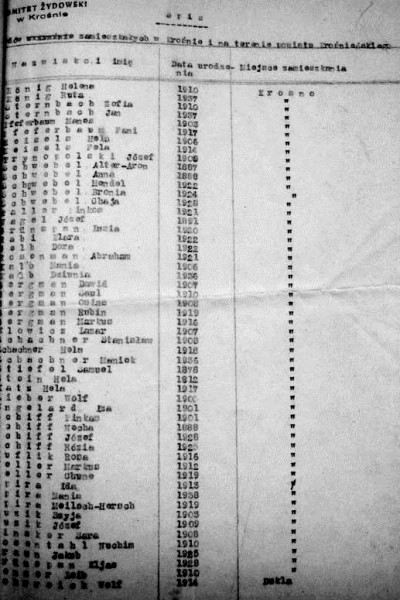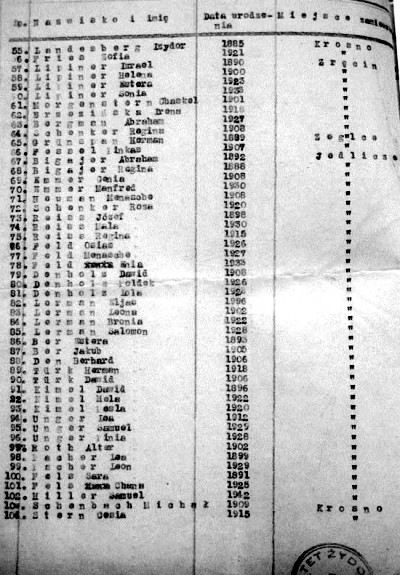 |
 |
|
|
[Page 193]
Some Krosner Jews came back, visited the city and then left. The city was strange to them and the faces were unfamiliar. It seemed to the returnees that this was not their Krosno. Their families were gone, their homes occupied by Poles, and their businesses destroyed. The returnees would have to start from scratch, and many decided against it. They packed their few belongings and decided to leave Krosno for the big cities or to leave Poland altogether. Other Jews decided to stay in Krosno and even established a Jewish community committee to help the returnees settle in the city.
|
|
The lists are difficult to read so we decided to rewrite them. We have two pages of names that follow the original name sheets. The second page has the official stamp of the Jewish committee of Krosno.
|
|
We copied the names as they were written with their mistakes. We notice that the list contained many Jews who were not native of Krosno but settled in the city following WWII to increase their personal security. The hamlets were near Krosno.
On May 15, 1945, the Jewish committee of Krosno also submitted a list of officers who were elected to represent the community. Their names and titles are as follows:
President Schachner,
All members are residents of the city of Krosno. Notice the community stamp and the official notations of the city of Krosno.
|
|
| Official letter to the mayor of Krosno. |
The Soviet–established Polish government steadily strengthened the Polish Communist party in its quest for total power. These moves were strongly opposed by the Polish nationalist forces that were well organized. Soon armed clashes took place between these two forces. The nationalist forces considered the Polish Jews outsiders and barely tolerated them. Their hatred of the Jews increased with the appointments of Jewish ministers like Jakub Berman and Hilary Minc to important cabinet posts.
A rare event in Poland between the wars was the appointment of a Jewish official to a high position in the government. This policy changed after the war. There were some Jewish ministers and high officials in the administration. Attacks against Jews began to take place in the countryside that was controlled by the nationalist forces. In September of 1945, a pogrom against Jews took place in Krakow, Galicia. Anti–Jewish incidents multiplied across Poland, their intensity increasing as Polish citizens began to return from the Soviet Union.
The first transports were primarily Polish farmers and skilled workers where the number of Jews was relatively small. As the transports kept coming, the percentage of Jews increased substantially. By July 1946, with the massive arrival of repatriated Polish Jews from the Soviet Union, the number of Jews in Poland swelled to 240,489. Most of the recent arrivals were sent to the new Polish areas where there were plenty of apartments and jobs. The German residents of these areas were forced to leave Poland. Large Jewish communities began to appear, namely Wroclaw (Breslau) and Walbrzych (Waldenburg), among others.
The Polish government and the American Joint helped the returnees settle, but the Polish countryside continued the fight against the Government and the Polish Jews. The height of the campaign reached the city of Kielce where 41 Jews and 4 Poles were killed on July 4, 1946.[1]
|
|
| The mass grave at Kielce, Poland following the pogrom. Under the pretext that a Christian child was kidnapped by Jews for ritual purposes, the Poles attacked the surviving Jews of Kielce. The fact that Polish security and police forces joined the mob sent alarm warnings to all Jews of Poland. Jews began to worry about their safety |
The news of the pogrom made headlines across the world and forced the Polish government to take action. The Polish government was sympathetic and understood the plight of the Jews, but it was powerless to restore order and also did not want to be too closely allied with the Jews. The Polish government decided to let the Jews leave Poland, regardless of internal or external consequences. The Polish government was primarily concerned with its own existence. The Assistant Minister of Defense of Poland, Marshal Marian Spychalski, was ordered to conduct secret negotiations with Itzhak or Antek Tzuckerman, one of the leaders of the Jewish ghetto uprising in Warsaw in 1943 and presently a member of the Central Committee of Polish Jews in Poland. They worked out a secret agreement whereby only Jews would leave Poland. No gold or foreign currency was permitted to leave the country, and all transportation arrangements were the responsibility of the Polish “Brichah”. All medical and special problems were to be handled by the Polish “Brichah”. The Polish government and the Polish official institutions were not officially involved in the Jewish exodus. Last but not least, no individual papers would be needed to leave Poland. The agreement was to commence on July 27, 1946, and end about February 1947. The agreement was secret and applied to the Polish–Czech borders.
In 1945, about 5,000 Polish Jews left Poland and crossed illegally to Czechoslovakia. The stream became stronger and in May of 1946, 3,052 Polish Jews entered Czechoslovakia. The number jumped to 8,000 in June. After the pogrom in Kielce, the tide turned to an avalanche. 19,000 Jews left Poland in July; 35,346 in August; and 12,379 in September of 1946. During 5 months, 77,700 Polish Jews left Poland and crossed the border at Nachod in Czechoslovakia. This was a major crossing point, but Jews crossed the border at several other border points. According to American Joint records, it is estimated that 90,000 Jews left Poland in 1946. Fear struck the Jews and they decided to pack and seek safety. The Polish countryside was losing the few Shoah surviving Jews who headed to the various crossing points along the long Polish–Czech borders. The main crossing points were at Kladzko, Walbrzych, Wroclaw, Krosno and Sanok.
|
|
The old “Brichah” road that went from Rowno through Czernowitz, Soviet Union, was closed with the arrest of the “Brichah” cell in Czernotz. The “Brichah”[2] leader, Abba Kovner, ordered 3 of his assistants to explore a new route that led to Romania. He selected Velvele Rabinowitz from Wilno as head of the group and send them to Krosno, across the Carpathian Mountains to Humene, Slovakia, Chust in Subcarpathia and Sato Mare in Romania[3] .The group reached Bucharest and met Moshe Auerbach, chief of the “Brichah” in Romania. Rabinowicz returned to Krakow, Poland and reported to the “Brichah” that the route was now open for Polish Jews to head to Romania and eventually to Palestine. Mordechai Rosman head of the Polish “Brichah” decided to open permanent bases for Jews, crossing the border at Rzszow and at Tarnow in Galicia. From there small groups would proceed to Krosno or Sanok where they would rest and then proceed cross the border to Slovakia where the Slovakian “Brichah” would take over.
|
|
|||
|
|
|||
Ben proceeded to Krosno and organized a base where the “Brichah” brought small groups of Jews that were about to cross the Carpathian Mountains. They had to rest, stock up on food and prepare for as long trip over the mountains. The Krosno station grew in importance as the number of Jewish refugees increased. The Krosno “Brichah” station would soon decline in importance as the crossing points shifted in a westerly direction, namely Kladzko, Walbrzych.
The road changed since the Romanian authorities closed the Constanta port facilities to the “Brichah” organisation. So there was no point in sending Jewish refugees to Romania with no further exits. Instead, the refugees were sent to Czechoslovakia and then to Germany and Austria where they entered the D.P. camps mainly in the American zones. Still, individual Jews who ventured into the Polish countryside took their lives in their hands as the tombstone below shows. Jews continued to live in the big cities like Krakow, Warsaw, Lodz, and Wroclaw.
|
|
| “Brichah” agents in Krosno; from right to left; Sarah Pressman, Lena Hemel, Stefan Grajek, Vi Feishter and a police official. The city of Krosno was located near the Polish-Czechoslovakian (presently Slovakian) border. The “Brichah” would bring groups of Jews that wanted to go to Palestine. In Krosno they received their final directions and instructions before they set out to leave Poland. |
With the liberation of the city of Krosno, some Jewish survivors began to appear, some partisans and discharged soldiers also visited the city of Krosno namelly Salek Berger, a native of Krosno, who survived the war in Eastern Ukraine and with the liberation of the area was drafted into the Polish Army. Following the war. He visited his native city and joined the “Brichah” in Krosno. According to Salek: “The “Brichah” organization was a secret organization dedicated to send all Jews of Eastern Europe to Palestine. The members of the organization were ex–partisans, camp survivors, discharged soldiers from the Jewish brigade and discharged soldiers from the Polish and Russian armies”. Berger joined led transports of Jews across the Polish–Czech border in the area of Krosno where he knew the paths. According to Berger, the work was difficult, dangerous and illegal. He remained with the organization for some time and then was replaced by another volunteer. Berger himself was sent to one of the D.P. camps in Italy where he remained for several years. He eventually reached the USA.
The city of Krosno was located near the Polish–Czechoslovakian (presently Slovakia) border. Surviving Jews reached the city as individuals or small groups and were organized into transports that crossed the border to Slovakia and then to Romania or Austria. Some individual Jews tried to reach the assembly point in Krosno but never made it as the memorial tombstone indicates.
|
|
With the end of the agreement, the Polish government closed all borders but continued to grant exit visas to Jews wanting to leave the country. The Polish “Brichah” organization slowly dismantled the organization in Poland as the government tightened control of the borders. The Krosno office was closed, the officials left the city, and all the Krosno Jews were gone. A community of about 3,000 Jews disappeared within such a short period of time. Thus ended Krosno Jewish history.
May they rest peacefully wherever they are buried.
Footnotes
|
|
JewishGen, Inc. makes no representations regarding the accuracy of
the translation. The reader may wish to refer to the original material
for verification.
JewishGen is not responsible for inaccuracies or omissions in the original work and cannot rewrite or edit the text to correct inaccuracies and/or omissions.
Our mission is to produce a translation of the original work and we cannot verify the accuracy of statements or alter facts cited.
 Krosno, Poland
Krosno, Poland
 Yizkor Book Project
Yizkor Book Project
 JewishGen Home Page
JewishGen Home Page
Copyright © 1999-2026 by JewishGen, Inc.
Updated 19 Dec 2015 by LA